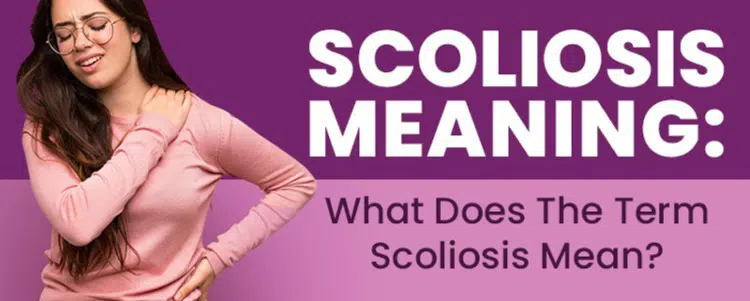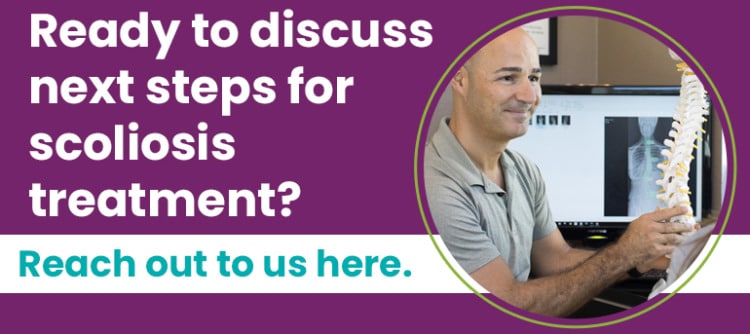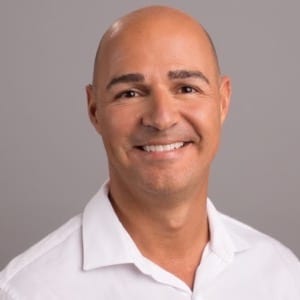Scoliosis is a highly-prevalent spinal condition with close to seven million people diagnosed in the United States alone, and keep in mind these are only known diagnosed cases. Depending on a number of important patient/condition variables, scoliosis doesn’t always produce noticeable symptoms, making early detection a challenge. Keep reading to learn more about the condition, including symptoms and treatment options.
The term scoliosis is ancient Greek and comes from the root skolios, meaning bent or crookedness. What it means to be diagnosed with scoliosis is that an unnatural sideways spinal curvature, with rotation, and of a minimum size, has developed, introducing a lot of uneven forces to the body.
Let’s start our discussion of scoliosis meaning by applying a literal translation to the term and the condition itself.
Understanding Scoliosis
As mentioned, the term scoliosis comes from ancient Greek, meaning bent or crooked, clearly based on the appearance the condition could cause.
The term scoliosis, and the condition itself, was first described by Hippocrates and Galen: Greek and Roman doctors of the ancient world.
While scoliosis has been around for thousands of years, there are still some aspects of the condition we don’t fully understand.
While ancient forms of treatment could involve tying patients to sticks in a type of external spinal fusion, thankfully, as our understanding of the condition has evolved over the years, so too has our mastery of how to treat it effectively.
If a person is diagnosed with scoliosis, this means they have a progressive structural spinal condition, with rotation, and a minimum Cobb angle measurement of 10 degrees; let’s break down each of these parameters that have to be met to reach a diagnosis of scoliosis.
Scoliosis is Progressive and Structural
One of the key characteristics of scoliosis is its progressive nature, meaning it will get worse over time, especially if left untreated, or not treated proactively.
In the context of scoliosis, getting worse means that the unnatural sideways spinal curvature will increase in size over time.
While there is no definitive means by which I can predict, with 100-percent accuracy, how one patient will progress compared to another, there are certain condition/patient variables that indicate a patient’s likeliest rate of progression.
In the condition’s main form, adolescent idiopathic scoliosis (AIS), diagnosed between the ages of 10 and 18, the idiopathic designation means not clearly associated with a single causative source; idiopathic scoliosis is instead considered multifactorial, meaning caused by multiple factors that vary from one patient to the next.
In fact, 80 percent of known diagnosed scoliosis cases are classified as idiopathic, with the remaining 20 percent falling into one of the following classifications with known causes: neuromuscular, congenital, degenerative, or traumatic scoliosis.
In typical forms of scoliosis, such as idiopathic, the curve bends to the right, away from the heart, but in atypical forms, such as the aforementioned 20 percent with known causes, the curve can bend to the left, towards the heart, and this complicates the treatment process.
While we don’t fully understand the etiology of idiopathic scoliosis, what we do understand is its number-one trigger for progression: growth.
So for children and adolescents who have not yet reached skeletal maturity, they are at risk for rapid-phase progression because of the rapid and unpredictable growth spurts associated with children and adolescents in the stage of puberty.
Scoliosis is a Structural Condition
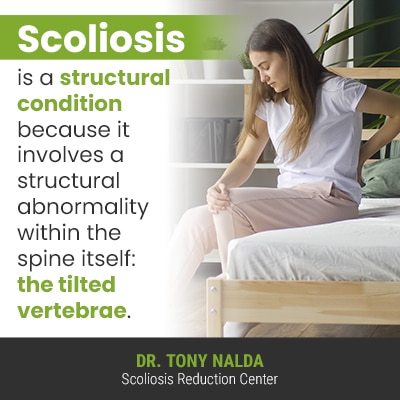
Scoliosis is a structural condition because it involves a structural abnormality within the spine itself: the tilted vertebrae.
The spine is made up of vertebrae (bones of the spine) stacked on top of one another in a straight and neutral alignment, but when one or more of these vertebral bodies are tilted unnaturally, this causes the spine to become misaligned and disrupts the biomechanics of the entire spine.
When a condition is structural, this means it’s caused by a defect in the affected portion of the body, so in scoliosis, we’re talking about the spine, as no change in position can reduce the size of the abnormal spinal curve because the problem is in the bones and structure of the spine itself.
Scoliotic Curves and Rotation
A healthy spine will appear straight when viewed from the front or back and take on a soft ‘S’ shape when viewed from the sides; this is due to the spine’s natural and healthy curves that characterize each of the spine’s main sections.
The main spinal sections are cervical (neck), thoracic (middle/upper back), and lumbar (lower back).
The spine’s natural curvatures make it stronger, more flexible, and better able to absorb/distribute mechanical stress, which is why a loss of one or more of the spine’s healthy curves is so disruptive to the spine’s overall health and function.
Another important characteristic that an unnatural spinal curve has to have to be officially diagnosed as scoliosis is a rotational component.
As mentioned, scoliosis is the development of an unnatural sideways spinal curvature, meaning the spine bends unnaturally to the side, but a scoliotic spine doesn’t just bend unnaturally to the side, but also twists from front to back, back to front: rotational component.
It’s the rotational component of scoliosis that makes it a 3-dimensional condition, and treatment can only be effective if the condition’s true 3-dimensional nature is addressed: a shortcoming of traditional treatment that we’ll return to later.
Cobb Angle and Condition Severity
Part of the diagnostic process is further classifying conditions based on a number of key patient and condition variables; this not only streamlines the treatment process but also informs the crafting of customized treatment plans, something the complex nature of scoliosis necessitates.
As such a highly-variable condition, severity is a key factor when it comes to assessing and treating scoliosis.
In order for scoliosis to be diagnosed, a patient’s unnatural sideways spinal curve has to have rotation and a minimum Cobb angle measurement of 10 degrees.
Cobb angle is known as the orthopedic gold standard in the assessment of scoliosis and is taken during X-ray.
Lines are drawn from the most-tilted vertebrae at the apex of the curve, and the resulting angle is measured in degrees, placing conditions on a severity scale of mild to moderate and severe to very severe.
- Mild scoliosis: Cobb angle measurement of between 10 and 25 degrees
- Moderate scoliosis: Cobb angle measurement of between 25 and 40 degrees
- Severe scoliosis: Cobb angle measurement of 40+ degrees
- Very-severe scoliosis: Cobb angle measurement of 80+ degrees
Condition severity is closely related to the topic of progression because as scoliosis gets worse, this means its Cobb angle is increasing, moving patients up the progressive line; where a patient’s scoliosis is at the time of diagnosis is not indicative of where it will stay because if left untreated, patients will experience increasing condition severity.
While each case is unique, as many patients progress, along with increasing condition severity comes increasing symptoms, and while mild scoliosis can be hard to detect early on because it typically doesn’t cause noticeable symptoms and/or functional deficits, as patients progress into the moderate and severe classifications, symptoms tend to become more overt.
Now that we have covered what it means to be diagnosed with scoliosis, let’s move on to the topic of scoliosis symptoms, and the main difference between adolescent and adult scoliosis.
Scoliosis Symptoms
As you can recall from the range of Cobb angle measurements, scoliosis develops across a wide severity spectrum, which is why no two cases are the same, and customization of effective treatment plans is so important.
While scoliosis is most prevalent in children and adolescents, it does also affect adults, but there is a big difference in how young and old experience the condition, and this is largely related to skeletal maturity.
Again, while each case is different, when it comes to scoliosis in children and adolescents, the most common symptoms are postural changes related to a disruption in the body’s overall symmetry; this is due to the uneven forces introduced by the condition.
Postural Changes in Adolescents and Adults
Whether these postural changes are subtle or overt will depend largely on condition severity and the angle of trunk rotation (ATR).
In general, the telltale signs of scoliosis in children and adolescents are:
- Uneven shoulders with one sitting higher than the other
- One-shoulder blade protruding more on one side than the other
- The development of a rib arch
- Uneven hips with one sitting higher than the other
- Uneven waistline
- Arms and legs that appear to hang at different lengths
These postural changes are related to how the condition disrupts the body’s natural symmetry, also known to cause ill-fitting clothing and changes to balance, coordination, and gait.
Now, when it comes to adults, they experience postural changes as well, most commonly a prominent lean to one side, uneven shoulder height, and/or the presence of a rib arch.
For all ages, postural changes caused by scoliosis are most noticeable when in a forward-bend position, which is why the Adam’s forward bend test is a widely-used physical examination that screens for signs of scoliosis and can indicate the need for further testing.
There is another common scoliosis symptom, although more common in adults: pain.
Scoliosis Pain in Adolescents and Adults
Pain is the main difference in how adolescents and adults experience the condition, and as mentioned, this is related to skeletal maturity.
In children and adolescents who have not yet reached skeletal maturity, their continuous growth keeps scoliosis from becoming a compressive condition; the lengthening motion of a growing spine counteracts the compressive force of the curvature, and compression of the spine and its surroundings (ligaments, nerves, and muscles) is the main cause of scoliosis-related pain.
Once skeletal maturity has been reached, scoliosis becomes a compressive condition, which is why, in adults, pain is the number-one reason they come to see me for a diagnosis and treatment.
Once compression becomes a factor, condition-related pain can range from mild and intermittent to chronic and debilitating, determined largely by patient age, condition severity, the angle of rotation, and the degree of nerve involvement.
If a spinal nerve is compressed, pain can be felt anywhere along its pathway, and remember, nerves are like branches on a tree, fanning off in different directions, which is why radicular pain can be felt far from its site of origin.
In fact, most adults who come to see me because of condition-related pain are feeling it in their arms, legs, and feet.
Radicular pain can feel sharp or dull, like electric shocks, and/or can cause feelings of tingling, numbness, and weakness.
In adolescents, while scoliosis isn’t commonly known as painful in terms of back and radicular pain, it should be mentioned that scoliosis can cause other types of pain.
It’s not just the spine that’s in charge of maintaining its natural curvatures and alignment, but also its surrounding muscles, and when the core muscles are struggling to support a spine that’s unnaturally curved, they can become strained, sore, and tight.
Approximately 20 percent of adolescents report feelings of muscle pain, even if not experiencing any other form of condition-related pain.
Scoliosis is also strongly associated with headaches and migraines; this is due to irregularities in the flow of cerebrospinal fluid (CSF) that protects the spine and brain.
So is scoliosis painful: not always, particularly in children and adolescents. In adults, the condition is compressive, and pain tends to be the most noticeable symptom.
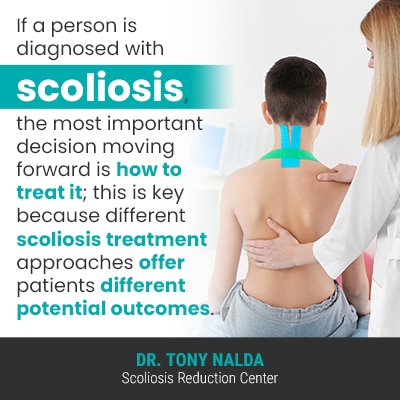
If a person is diagnosed with scoliosis, the most important decision moving forward is how to treat it; this is key because different scoliosis treatment approaches offer patients different potential outcomes.
Scoliosis Treatment Options
There are two main scoliosis treatment approaches that give patients very different options in terms of the process and potential results: traditional and conservative.
While being the dominant choice for many years, the traditional approach has changed little, even as our understanding of the condition and treatment efficacy has evolved over the years.
The traditional approach is often described as reactive, versus the proactive response offered by proponents of a conservative treatment approach.
Traditional Scoliosis Treatment Options
In traditional treatment, if a patient is diagnosed with mild scoliosis, meaning a Cobb angle measurement of between 10 and 25 degrees, the response would be solely to watch and wait for signs of further progression.
Remember, as discussed earlier, scoliosis is a progressive condition, meaning virtually every case will get worse at some point.
Here at the Scoliosis Reduction Center®, I see this as wasting valuable treatment time; I see a mild scoliosis as an opportunity to keep it that way through proactive treatment.
A traditional approach would suggest watching and waiting, likely with periodic X-rays and physical exams to monitor the spine for progression, but the issue with that is growth; considering the main form of AIS, these patients are in an age group known for its rapid and unpredictable growth spurts.
As we know, growth is the main progressive trigger, and as adolescents are at risk for rapid-phase progression, in between check-ups, it’s likely that patients can have significant growth spurts, and the risk is that by only monitoring, instead of applying proactive treatment early on, significant progression can occur unimpeded.
While there are no treatment guarantees, it’s never too late to start treatment, and a condition that’s caught early on in its progressive line has higher chances of treatment success, but only if the condition is responded to with proactive treatment.
Under a traditional approach for treating AIS, the patient would be monitored while mild, and would continue to be monitored, without applying any form of treatment, until they showed continued progression into the moderate and severe level.
When it’s clear that a patient’s scoliosis will continue to get worse, usually in the late-moderate stage, a traditional approach would likely attempt scoliosis bracing as a treatment option to prevent further progression into the severe classification.
It’s important for patients, and their families, to understand that just as there are different treatment approaches for scoliosis, there are different scoliosis braces to choose from, and not all are created equal.
Under the banner of traditional treatment, the most common traditional brace used in the United States is the Boston brace, and like the general traditional treatment approach itself, the brace’s design has changed little over the years.
The Boston brace is known to have a number of shortcomings:
- Mass-produced
- Uncomfortable/bulky to wear
- Doesn’t offer corrective potential
- Squeezes the spine unnaturally
- Can weaken the spine
- Can lead to weakened core muscles
- Can increase postural deviation
- Breathing difficulties can cause extra activity restrictions
- Issues with compliance
- Has to be worn full time (18 to 23 hours a day for anywhere up to 5 years)
The majority of these shortcomings are related to its design which doesn’t have correction as its end goal, but rather slowing/stopping progression; this isn’t the same as actually working towards correcting the structural abnormality itself (corrective results).
In addition, the design of the Boston doesn’t address the condition’s true 3-dimensional nature as it only squeezes the brace from the sides, not accounting for the condition’s rotational component.
If a Boston brace is prescribed to an adolescent patient and it doesn’t prevent further progression and they cross into the severe classification level, once they pass the surgical-level threshold at 40+ degrees and show continued progression, the majority of patients are funneled into a spinal-fusion recommendation.
While surgeons have their patients’ best interests at heart, and all surgical procedures come with their share of risks, spinal fusion is costly, lengthy, invasive, and carries some significant side effects and risks of complications.
In addition, there are no guarantees that spinal fusion will stop progression, and the process of fusing the most-tilted vertebrae together into one solid bone can work to eliminate movement in the area (progression), but that also comes at the cost of spinal flexibility: an outcome that many patients are disappointed with.
Conservative Scoliosis Treatment and the Scoliosis Reduction Center®
Conservative treatment, also known as chiropractic-centered and/or functional, responds very differently to a scoliosis diagnosis.
Here at the Center, we acknowledge that most cases of scoliosis are going to progress at some point, so why not take action while conditions are mild and easier to correct, rather than monitoring while conditions progress unimpeded, becoming more complex to treat in the future.
As a scoliotic curve increases in size, not only do symptoms tend to increase as well, but the spine can get increasingly rigid (particularly in adults once conditions become compressive), making it less responsive to treatment, and the longer a scoliotic curve remains untreated in the body, the more time the body has to adjust to its presence.
Patients of the Center benefit from proactive treatment that integrates multiple treatment modalities applied as close to the time of diagnosis as possible.
While preserving the spine’s overall health and function are the main goals of my treatment approach, helping patients avoid increasing condition severity, escalating symptoms, and the need for more invasive forms of treatment down the road are equally motivating.
By combining condition-specific chiropractic care, in-office therapy, custom-prescribed home exercises, and corrective bracing, I can offer patients the most customized and specific treatment results.
In contrast to the Boston brace, for my bracing needs, my top choice is the ultra-corrective ScoliBrace: a modern and dynamic approach to bracing that represents the culmination of what we’ve learned about scoliosis and bracing efficacy over the years.
The ScoliBrace has a different end goal than traditional scoliosis braces: correction. It accomplishes this by addressing many of the Boston’s shortcomings:
- Custom-designed for each body/condition type
- More comfortable to wear, less bulky
- Better compliance
- Offers corrective potential
- Pushes the spine, instead of squeezing
- Correction improves postural deviation
- Less activity restrictions
Unlike the Boston, the ScoliBrace offers corrective potential because it addresses the condition’s 3-dimensional nature, working towards correcting both the spine’s sideways bend and the rotational component.
Conclusion
So what does scoliosis mean? The term itself is a Greek term for bent or crooked, and what it means to have scoliosis is living with a progressive condition that causes an unnatural sideways spinal curve.
The uneven forces introduced by scoliosis can cause postural changes, pain (more common in adults), and related complications (lung impairment, digestive issues) in severe forms, and particularly if left untreated, or not treated proactively.
If you have noticed scoliosis indicators in yourself, or a loved one, the time to act is always now; while there are never treatment guarantees, there are many benefits to early detection, but only if the condition is responded to proactively.
While a traditional approach would respond to a mild condition with monitoring and only apply bracing once the conditions have progressed and continue to do so, a conservative approach does the opposite: starts treatment early to keep conditions mild and prevent increasing condition severity.
Here at the Scoliosis Reduction Center®, I encourage patients, and their families, to research all treatment options available to them as different approaches offer different outcomes: a decision that can have far-reaching consequences.
For those looking for a proactive noninvasive form of treatment, don’t hesitate to reach out to us here at the Center for further guidance and support.
